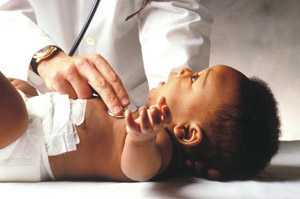Beyond the Blood Spot: Newborn Screening for Hearing Loss and Critical Congenital Heart Disease
Tuesday, September 20, 2016 at 1 p.m. EDT
 Newborn screening began in the United States in the 1960s to test for medical conditions that may not be apparent just by looking at a baby. Finding these conditions soon after birth can help prevent certain serious problems, such as brain damage, organ damage, and even death. The traditional method of newborn screening is bloodspot testing, wherein blood is sent to a lab to be screened for a number of conditions. There is also a newer paradigm of point-of-care newborn screening to test for hearing loss and critical congenital heart defects, conditions that are not identifiable through blood tests.
Newborn screening began in the United States in the 1960s to test for medical conditions that may not be apparent just by looking at a baby. Finding these conditions soon after birth can help prevent certain serious problems, such as brain damage, organ damage, and even death. The traditional method of newborn screening is bloodspot testing, wherein blood is sent to a lab to be screened for a number of conditions. There is also a newer paradigm of point-of-care newborn screening to test for hearing loss and critical congenital heart defects, conditions that are not identifiable through blood tests.
Both traditional bloodspot screening and the newer point-of-care screening tests share the goals of making sure that newborns are tested for certain potentially life-threatening conditions, and ensuring that providers follow up based on test results. The newer tests, however, do pose some unique challenges for public health. Because these tests take place in the health care setting rather than in a lab, it is difficult to standardize both the implementation of the tests and reporting of the test results. Newborn screening is also mandated by each individual state, so tests required in some states may not be in others.
In this session of Public Health Grand Rounds, you will hear how some states have implemented point-of-care newborn screening and what challenges they have faced in standardizing these tests and tracking test results. Speakers will also discuss how public health partners at all levels can work toward ensuring that every baby is screened.
Presentation:
Beyond the Data – Beyond the Blood Spot: Newborn Screening for Hearing Loss and Critical Congenital Heart Disease
Newborn screening began in the United States in the 1960s to test for medical conditions that may not be apparent just by looking at a baby. Finding these conditions soon after birth can help prevent certain serious problems, such as brain damage, organ damage, and even death.
Presented By:
Stuart K. Shapira, MD, PhD
Associate Director for Science and Chief Medical Officer
National Center on Birth Defects and Developmental Disabilities, CDC
“Advancing the Science of Newborn Screening”
Marci K. Sontag, PhD
Associate Professor, Colorado School of Public Health
University of Colorado Denver Anschutz Medical Campus
“The Federal Partner Perspective”
Kim Van Naarden Braun, PhD
Epidemiologist, Division of Family Health Services, New Jersey Department of Health
Division of Congenital and Developmental Disorders
National Center on Birth Defects and Developmental Disabilities, CDC
“Implementing and Evaluating CCHD Screening in New Jersey”
Craig A. Mason, PhD
Professor, Education and Applied Quantitative Methods
University of Maine
“From Data to Action: The EHDI Experience”
Facilitated By:
John Iskander, MD, MPH, Scientific Director, Public Health Grand Rounds
Phoebe Thorpe, MD, MPH, Deputy Scientific Director, Public Health Grand Rounds
Susan Laird, MSN, RN, Communications Director, Public Health Grand Rounds
Continuing Education
This session is available for Continuing Education. Click here for more information.
- Page last reviewed: September 26, 2016
- Page last updated: September 26, 2016
- Content source:
- Centers for Disease Control and Prevention
- Page maintained by: Office of Associate Director of Communication, Division of Public Affairs



 ShareCompartir
ShareCompartir